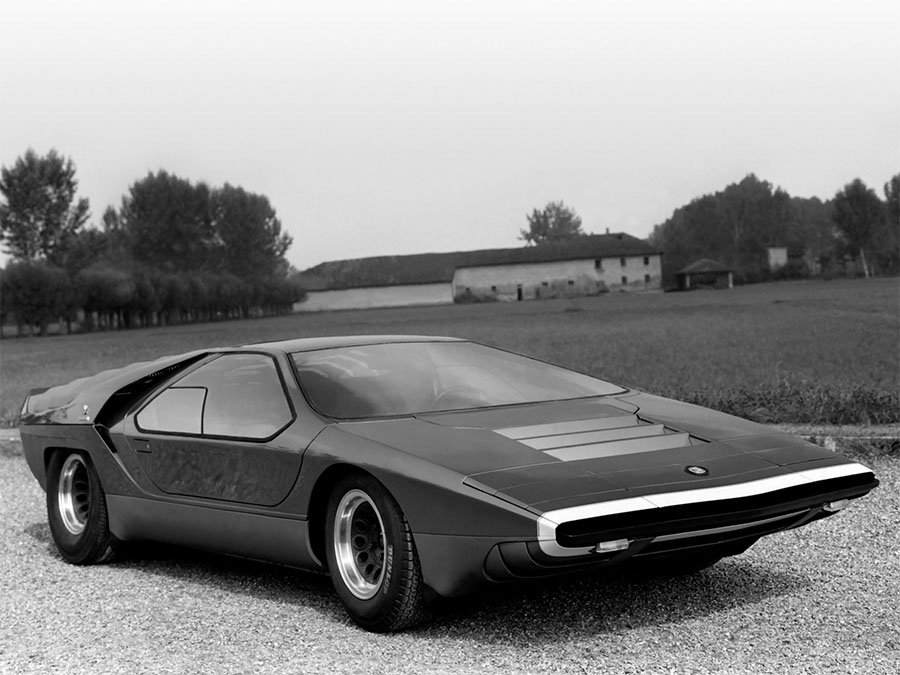Guide: Alfa Romeo Tipo 33 Stradale Bertone Carabo - a Historical & Technical Appraisal
/BACKGROUND
Although Alfa Romeo had anticipated a production run of 50 Tipo 33 Stradales would be built in order to secure Group 4 homologation, only eleven standard examples are known to have been completed.
A batch of 20 rolling chassis had been assembled which left the firm with a dilemma about what to do with with the unsold naked units.
As coachbuilders had long since favoured competition chassis on which to construct their most daring and exciting concepts, the decision was made to send Alfa’s leftover Tipo 33 Stradales to Italy’s top automotive design houses.
Six Tipo 33 Stradale show cars emerged (one chassis was used for two different bodies): two arrived in 1968, two in 1969, one in 1971 and the last in 1976.
First to appear was chassis 750.33.109 which was unveiled at the Paris Motor Show in October 1968.
The chassis had been sent out to Bertone in the spring of that year where it was transformed into the astonishing Carabo.
BODYWORK
The Carabo remains one of the most influential concept cars ever produced. Styling-wise, it ushered in a new era of wedge design.
Bertone named the car after the Carabidae beetle that inspired its metallic green and orange colour scheme.
The ground-breaking creation was designed at Bertone by Marcello Gandini and, although not intended for production, it was nevertheless fully functional.
The principle of Gandini’s wedge profile was not purely aesthetic; it was partly the need to eliminate high speed lift that dictated the revolutionary design path.
During the 1960s, increasingly fast racing cars had began to sprout all manner of fins, canards and spoilers in an attempt to keep them planted firmly to the ground. Gandini reasoned the entire body should create the downforce required and spearheaded a new design language for the automotive industry.
Bereft of almost any supplementary aerodynamic devices, the Carabo was a masterful mix of flat surfaces and soft curves.
The full width nose aperture was partially filled with an innovative impact absorbing bumper. More fresh air was fed to the radiators by way of discrete intakes carved out from the lower nose section.
Headlights were concealed behind retractable flaps and the front lid was home to a bank of three large vents that enabled hot air to escape from the radiator.
The windscreen was only slightly more inclined than the front bodywork while the enormous side windows had small sub-sections that could be raised or lowered.
Access to the cockpit was by front-hinged scissor doors that became a Gandini trademark.
Behind each door were two mirror-image intakes to cool the engine and brakes.
The upper rear bodywork was hinged at its trailing edge and accessorised with half a dozen wraparound louvres finished in satin black to match the lower body sections. Another interesting feature was the tail fascia grid that concealed the rear lights. Five rubber pads replaced a conventional rear bumper.
INTERIOR
Inside, the cockpit was no less futuristic. A 300kmh speedo and 10,000rpm tach were angled towards the driver at either end of an unconventional full width dash.
Most of the supplementary gauges were located behind an elaborately dished four spoke steering wheel.
Black vinyl was originally used to upholster the dash, sills, door panels, central console and bucket seats but much of this was later switched to alcantara suede.
CHASSIS
Mechanically the Carabo was based on a standard Tipo 33 Stradale which itself was derived from the big tubed perimeter chassis of the 1967 Tipo 33 racing car. The competition spaceframe comprised two light-alloy side members that doubled up as fuel tanks with front and rear subframes to carry the suspension, engine, gearbox and differential.
Suspension was via wishbones, helical springs and anti-roll bars with radius rods additionally installed at the back. Fully adjustable telescopic dampers were fitted all round along with ventilated disc brakes (mounted inboard at the rear).
13-inch diameter magnesium wheels measured 10-inches wide at the front and 12-inches wide at the back. They were originally shod with Dunlop tyres.
ENGINE / TRANSMISSION
Alfa’s compact and lightweight all-alloy 90° V8 was a highly specialised piece of kit. It featured two chain driven overhead camshafts per bank, four ignition coils, dry-sump lubrication SPICA fuel-injection and 16 spark plugs. A capacity of 1995cc was achieved thanks to a bore and stroke of 78mm and 52.2mm respectively.
The compression ratio was 10.0:1 which gave a peak output of 230bhp at 8800rpm.
Transmission was via a five-speed Colotti gearbox with a ZF limited-slip differential and single-plate hydraulic clutch.
SUBSEQUENT HISTORY
As expected, the Carabo caused a sensation at the 1968 Paris Motor Show. It kick started a new wedge era and proved enormously influential. However, few subsequent designs were able to match this beautifully executed pioneer.
After its show career was over, the Carabo made its way to Alfa Romeo’s factory collection where it resides to this day.
Text copyright: Supercar Nostalgia
Photo copyright: Alfa Romeo - https://www.alfaromeo.com & Bertone - https://www.bertone.it






































